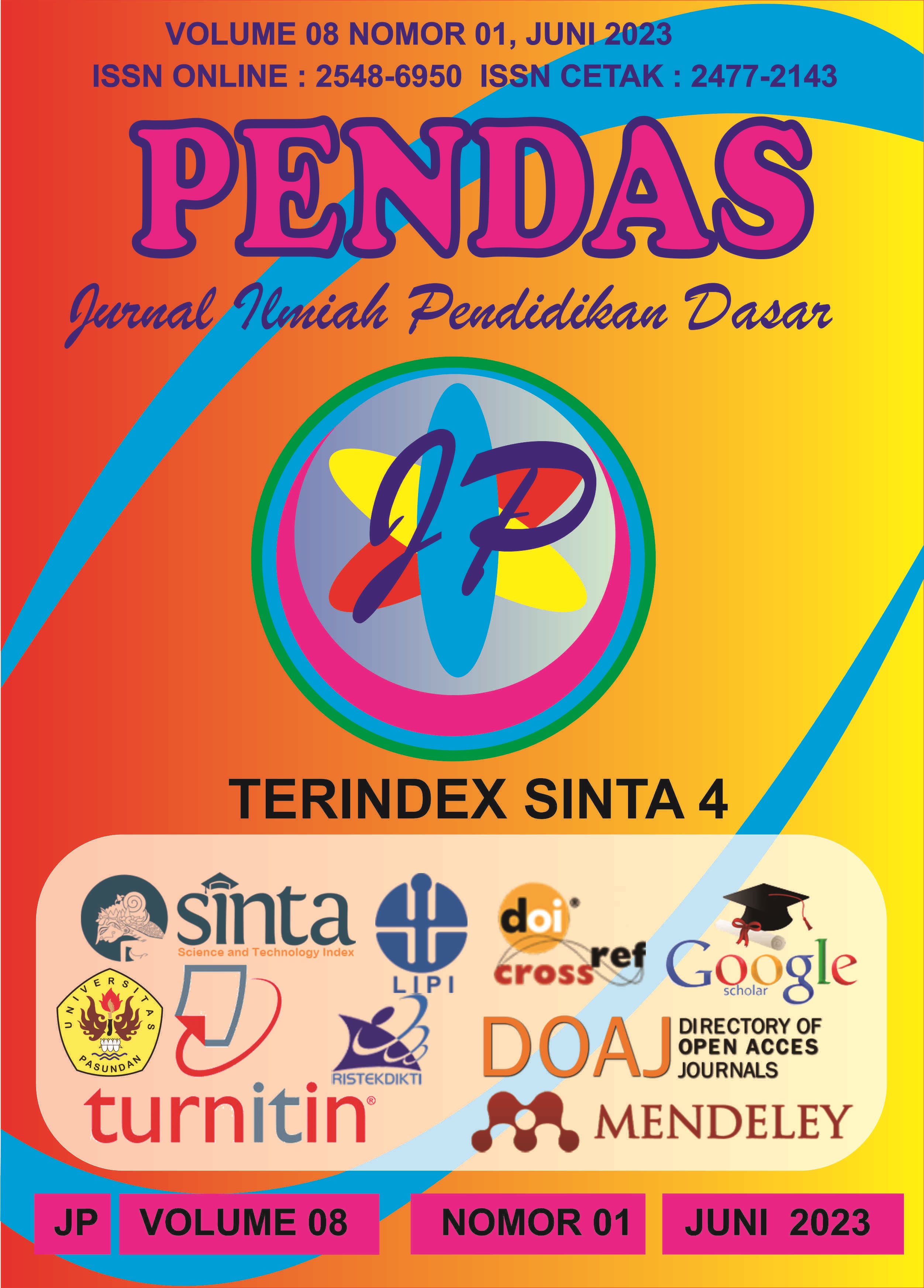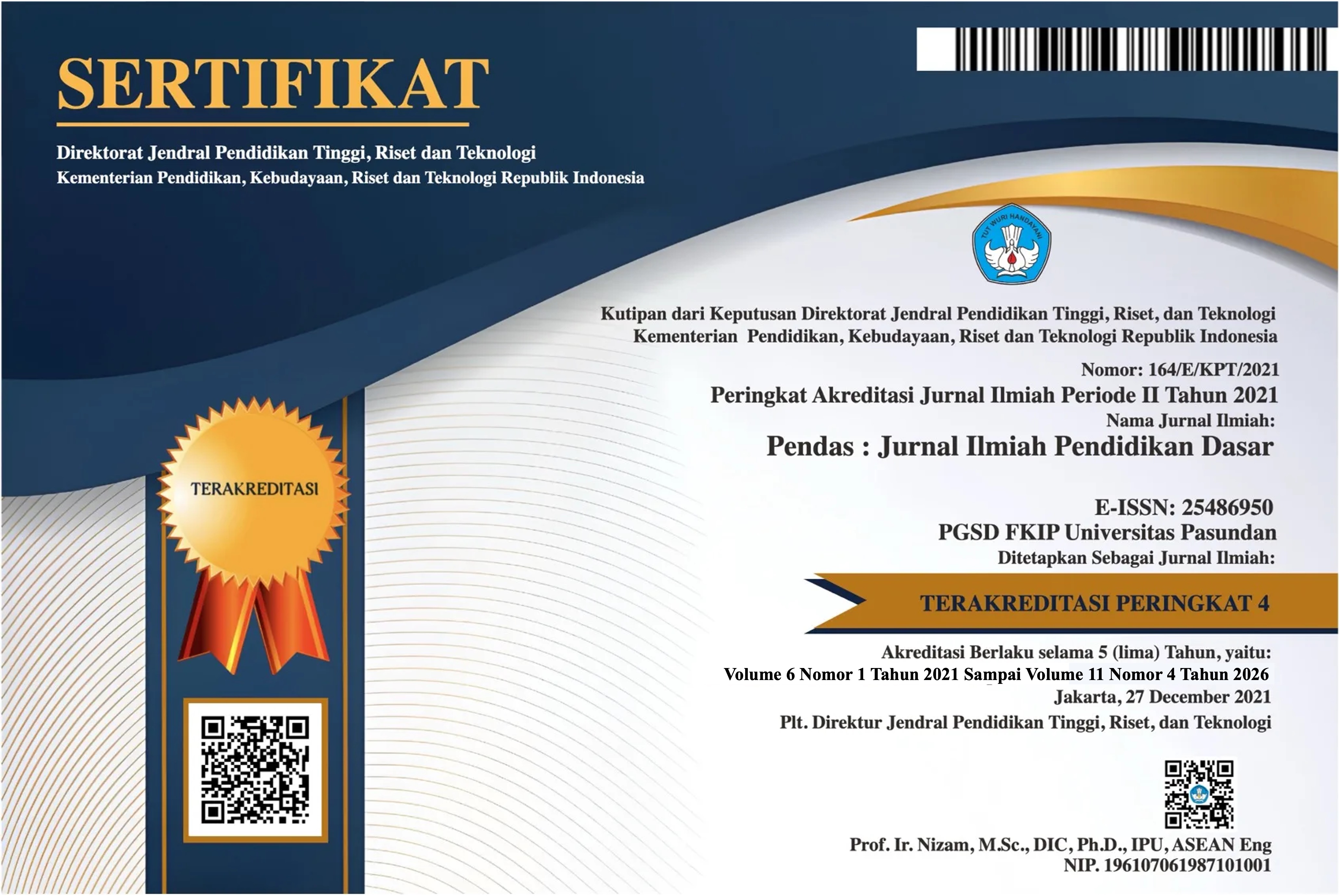PENERAPAN MODEL BAMBOO DANCING TERHADAP MOTIVASI BELAJAR IPA MATERI SIFAT-SIFAT CAHAYA KELAS IV SD
DOI:
https://doi.org/10.23969/jp.v8i1.8993Keywords:
Bamboo Dancing Model, Motivation, SciencesAbstract
This study aims to determine the extent to which students' motivation in learning natural science material properties of light in class IV. The method used by researchers in this study is a quantitative descriptive method. The data collection technique in this study was the questionnaire method and the documentation method. The population and sample in this study were grades IV A and IV C, totaling 58 students. The data obtained by the researchers in this study used a motivational questionnaire on the properties of light. The trials that the researchers carried out using a questionnaire that had been validated by the lecturer aimed at determining whether the questionnaire items were valid or not. The data were analyzed using the Pearson correlation validity test which obtained rcount = 0.6634 and rtable = 0.5140 with the Cronbach alpha reliability test of 0.76, so that rcount = 0.6634 > rtable = 0.5140. So that the questionnaire items are declared valid and suitable for use by researchers. The results of the study were obtained from the results of a comparison of the value of the criteria for class IV A and IV C. Class IV A showed that the results of the questionnaire with the most criteria were Good, while class IV C showed the results of the questionnaire with the most criterion values were Very good. It can be concluded that the bamboo dancing model can increase students' motivation in learning science about the properties of light for class IV SD.Downloads
References
Alwinda, A., & Wiguna, S. (2022). Upaya Meningkatkan Hasil Belajar Siswa Melalui Model Pembelajaran Bamboo Dancing Pada Mata Pelajaran Sejarah Kebudayaan Islam Di Kelas VIII Mts Al-Hidayah Gebang. Dewantara: Jurnal Pendidikan Sosial Humaniora, 1(4), 155-166.
Ayurachmawati, P., Syaflin, S. L., & Prasrihamni, M. (2022). Pengembangan Multimedia Berbasis Kearifan Lokal Pada Muatan Materi IPA di SD. Jurnal Cakrawala Pendas, 8(3), 941-949.
Khadijah, I. (2022). Peranan Serta Komponen Kompetensi Penting Yang Harus Di Miliki Seorang Guru Profesional.
Magdalena, I., Annisa, M. N., Ragin, G., & Ishaq, A. R. (2021). Analisis Penggunaan Teknik Pre-Test Dan Post-Test Pada Mata Pelajaran Matematika Dalam Keberhasilan Evaluasi Pembelajaran Di Sdn Bojong 04. NUSANTARA, 3(2), 150-165.
Moko, S. N. A. (2022, January). Penerapan Model Pembelajaran Bamboo Dancing Dalam Meningkatkan Aktivitas Belajar Ipa Siswa Di Sekolah Dasar. In prosiding seminar nasional pendidikan dasar.
Muhasim, M. (2017). Pengaruh Tehnologi Digital Terhadap Motivasi Belajar Peserta Didik. Palapa, 5(2), 53-77.
Ngabidin, M. (2021). Pembelajaran Dimasa Pandemic, Inovasi Tiada Henti (Kumpulan Best Practice Pembelajaran Pada Sekolah Model Dimasa Pademi Covid 19) SD. Yogyakarta. Group Penerbitan CV Budi Utama.
Novitasari, D. (2017). Upaya Meningkatkan Keaktifan Dan Hasil Belajar Siswa Pada Mata Pelajaran Sosiologi Melalui Penerapan Model Cooperative Learning
Tipe Bamboo Dancing (Tari Bambu) kelas XI IPS 3 SMA Negeri Kebakkramat Tahun Pelajaran 2016/2017. SOSIALITAS; Jurnal Ilmiah Pend. Sos Ant, 7(2).
Nuryanti, R. (2019). Penggunaan Model Pembelajaran Kooperatif Dengan Strategi Team Games Tournament (Tgt) Untuk Meningkatkan Hasil Belajar Matematika Pada Materi Bilangan Romawi Bagi Siswa Tunarungu Kelas Iv Sdlb (Penelitian Eksperimen dengan One Group Pretest Posttest Design Di SLB B Sukapura Kota Bandung). JASSI ANAKKU, 20(1), 40-51.
Pratiwi, A. (2017). Penerapan Model Bamboo Dancing Terhadap Motivasi Belajar IPA. Jurnal Pendidikan IPA Indonesia, 6(2), 156-165.
Putri, C. M., Ysh, A. S., & Azizah, M. (2019). Implementasi Model Bamboo Dancing Berbantu Media Name Card dalam Meningkatkan Hasil Belajar Kognitif Sekolah Dasar. Journal of Education Action Research, 3(4), 316-323.
Samsuddin, G., Irman, R., & Khaedar, M. (2021). Peningkatan Hasil Belajar Bahasa Indonesia Melalui Model Pembelajaran Bamboo Dancing Kelas VI SD Inpres Manggala Kecamatan Manggala Kota Makassar. EDULEC: Education, Language and Culture Journal, 1(1), 9-19.
Santoso, B. (2018). Bamboo Dancing: A Fun and Interactive Approach to Enhance Students' Motivation in Learning Science. Indonesian Journal of Science Education, 6(1), 45-54.
Setiawan, F. (2021). The Effect of Bamboo Dancing Model on Students' Interest in Science Learning. Journal of Science Learning, 4(2), 87-96.
Siahaan, K. W., Sinabutar, A. T., & Haloho, U. H. (2020). Pengaruh Metode Quantum Teaching Dalam Menciptakan Pembelajaran Yang Aktif Dan Menyenangkan Pada Anak SD.
Sugiyono. (2016). Metode Penelitian Pendidikan Pendekatan Kuantitatif dan R&D. bandung. Alfabet.
Sugiyono. (2020). Metode Penelitian Kuantitatif Kualitatif dan R&D. Bandung: Alfabeta.
Suratiningsih, S. (2021). Puzzle Sebagai Solusi Peningkatan Motivasi Belajar Siswa. At-Tarbawi: Jurnal Pendidikan, Sosial dan Kebudayaan, 8(1), 15-26.
Syaparuddin, S., & Elihami, E. (2019). Peningkatan Motivasi Belajar Siswa Melalui Video Pada Pembelajaran PKN Di Sekolah Paket C. Jurnal Edukasi Nonformal, 1(1), 187-200.
Kesumawati, M., & Aridanu, I. (2018). Statistik Parametik Penelitian Pendidikan. Palembang. Noerfikri Offset.
Widodo, B. (2020). Enhancing Students' Motivation in Science Learning through Bamboo Dancing Model. Journal of Educational Research and Evaluation, 8(1), 23-34.
Wijaya, A. (2019). Social Skills Development of Students through Bamboo Dancing Model in Science Learning. International Journal of Science Education, 7(2), 112-123.
Yuliastri, A., Oktavia, M., & Nuranisa, N. (2017). Perbandingan Model Pembelajaran PBL (Problem Based Learning) Dan Model Pembelajaran Discovery Learning Terhadap Keaktifan Belajar Siswa Di SMA PGRI 2 Palembang. JPG (Jurnal Pendidikan Geografi), 9(2).
Downloads
Published
Issue
Section
License
Copyright (c) 2023 Pendas : Jurnal Ilmiah Pendidikan Dasar

This work is licensed under a Creative Commons Attribution 4.0 International License.



















